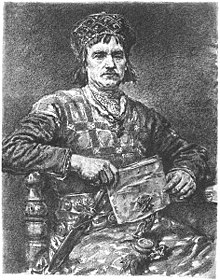Boleslaus V of Poland
| Bolesław V the Chaste | |
|---|---|

19th century portrait by Jan Matejko.
|
|
| High Duke of Poland | |
| Reign | 1243–1279 |
| Predecessor | Konrad I of Masovia |
| Successor | Leszek II the Black |
| Duke of Sandomierz | |
| Reign | 1227–1230 1232–1279 |
| Predecessor | Boleslaus I of Masovia |
| Successor | Leszek II the Black |
| Born | 21 June 1226 Stary Korczyn |
| Died | 7 December 1279 Kraków |
| Burial | Church of St. Francis of Assisi, Kraków |
| Spouse | Kinga of Poland |
| House | House of Piast |
| Father | Leszek I the White |
| Mother | Grzymisława |
Bolesław V the Chaste (Polish: Bolesław Wstydliwy; 21 June 1226 – 7 December 1279), was a Duke of Sandomierz in Lesser Poland from 1232 and High Duke of Poland from 1243 until his death, as the last male representant of the Piast Lesser Poland branch.
Bolesław V was born on 21 June 1226 at Stary Korczyn, as the third child and only son of Leszek I the White by his wife Grzymisława, a Rurikid princess of disputed parentage.
Named after his great-grandfather Bolesław III Wrymouth, the V numeral was assigned to him in the Poczet królów Polskich. His nickname of "Chaste" (Latin: Pudicus), appeared relatively early and was already mentioned in the Rocznik franciszkański krakowski. It was given to him by his subjects because of the vows of chastity that Bolesław V and his wife Kinga of Hungary jointly taken; for this reason, their marriage was never consummated. The marital chastity and lack of mistresses by the Prince resulted from his exceptional devotion and mortification, and was evidently influenced by his closest female relatives.
On 24 November 1227, during the Congress of Gąsawa, Bolesław V's father Leszek I the White was killed. Like his own father and grandfather before him, he was orphaned at young age. After Leszek I's death many people claimed the custody of his only son. The nobility of Kraków wanted that the regency must be exercised by the Dowager Duchess Grzymisława, jointly with the local voivode and Bishop; however, this was contrary with the treaty of mutual inheritance signed in 1217 between Leszek and Władysław III Spindleshanks, under which was agreed that in the event of the death of one of them, the other would take the government of his domains and custody of his minor children.
On 6 December 1227 Casimir I of Kuyavia -who probably represented his father at the funeral of Leszek I-, advanced his claims over the custody of Bolesław V and his inheritance as his closest male relative. Due to the lack of response, in the first half of March 1228 Konrad I of Masovia came to Skaryszew to negotiate with Grzymisława and the local nobility to assuming the guardianship of his nephew during his minority. The nobility, especially the Gryfici among them, preferred the rule of Władysław III Spindleshanks, but at that point he was in the middle of his fight against his nephew Władysław Odonic and was unable to claim his rights. Konrad I then appeared in the northern part of Kraków, but at his side were only the Topór and Sztarza families, and for this his attempt to take the Seniorate failed. According to Kazimierz Krotowski, the absence from Lesser Poland was the cause of the Prussian invasion to Masovia. On 5 May 1228 was organizated at Cienia a meeting between Władysław III Spindleshanks and a delegation of Kraków nobles, who included Bishop Iwo Odrowąż, voivode Marek Gryfita, Pakosław Awdaniec the Old, voivode of Sandomierz and Mściwój, castellan of Wiślica. Under the terms of the meeting, Władysław III agreed with the adoption of Bolesław V, making him his successor over Kraków and Greater Poland. After the meeting, Władysław III arrived to Kraków, where Grzymisława formally gave him the rule of the city. The Dowager Duchess and her son received the Duchy of Sandomierz, where she exercised the regency.
...
Wikipedia
